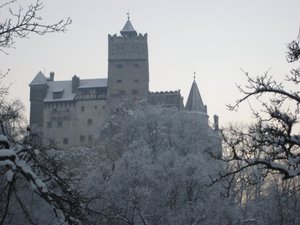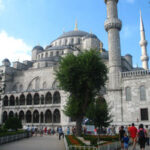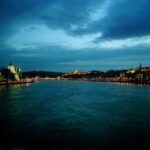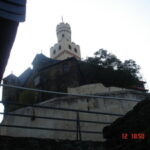I love fortifications that are ideally suited for their geographic location. I live in Istanbul, which is one of the most obviously defensible strong points in the Eastern Mediterranean. I visited Visegrad in Hungary, whose citadel towers over the Danube at a critical bend where it protects the approaches to Budapest and Vienna. Bran Castle is another well situated outpost.
Bran Pass is a winding and picturesque break in the Carpathians through which the armies of Transylvania could travel lightning quick and catch any invading army of guard on the plains of Walachia to the south. Vlad Dracula used the pass this way. As ruler of Walachia, Vlad would hole his armies up in the Carpathians and strike with terrifying ferocity, leaving the wounded and captured of his enemies impaled on pikes as a warning to future invaders. Vlad was one of the few men that the Turks actually feared. According to legend, Mehmed the Conqueror, leading his troops into Walachia to fight Vlad Tepes, encountered a forest of Vlad’s impaled victims and turned back to Constantinople in disgust, leaving command of the army to his subordinates.
Bran Castle is commonly referred to as “Dracula’s Castle” though there is no evidence that he actually lived there. The castle was constructed in the 13th century by the Teutonic Knights in nearby Brasov. The German influence on its architecture is obvious as it lacks the pointed spires or onion domes of most eastern buildings. There are two connections between Vlad Tepes and Bran Castle. Firstly it seems that Prince Vlad was briefly imprisoned in the castle after he was finally captured by the Ottomans. Secondly, Bram Stoker, is believed to have been inspired by Bran Castle as the model for the castle of Count Dracula. The locals care little about whether or not the real Dracula lived in Bran Castle-they sell a menagerie of t-shirts, thimbles, plates and assorted sundry souvenirs to the visitors of Romania’s most famous landmark.
Getting to Bran is not very easy. My fiancée, Carrie, and I set out from the Transylvanian town of Brasov on a fiercely cold day with a heavy snow fog blanketing the city. We took a taxi to Brasov’s #2 bus station, which is a confusing assortment of taxis and locals seeking out small, dingy buses to nearby towns and villages as well as tourists piling on to gargantuan international coaches to far flung corners of Europe. Carrie and I just missed a bus to Bran and had to wait an hour in the station trying to keep our feet out of the mud and fending off the would-be thievery of gypsy children.
At 1:00 we finally boarded our bus, which was a local running between Brasov and Moesti. We had no idea how far along the line Bran would be or what it would look like. We paid the 7 lei fare ($3) and grabbed seats before the bus fully crowded. The locals boarded in droves bearing Christmas presents and luggage. The bus chugged along through traffic on the outskirts of Brasov until we finally cleared the city limits and made it out into the open country of Transylvania. The fog lifted, allowing the sunshine through. Mountains rose around us in low wooded hills and jagged far off peaks. The fields were filled with sheep grazing on what blades of grass poked through the uniform blanket of white.
After a half hour journey some teenagers pointed out Bran to us. We exited the bus in a small suburban town. Advertisements for hotels and shops were quick reassurance that we had found our place. The road on which we walked, seeking out the entrance to the castle grounds, route 73, is essentially the route of the old Bran Pass. Around a bend we saw it. Our first glimpse of Bran Castle was that of a large fortress peeking through the pines on a hill overlooking the town. It had a high boxy tower topped by a cupola, small cone-shaped turrets and slit-like windows. It certainly looked foreboding and I could only imagine it looking more so on a moonlit night but I did not expect it to be so beautiful.
Carrie and I wound our way through the booths selling trinkets and bought our tickets. The price of admission was 12 lei each (about $5). Once through the admission kiosk we took in the scenery around us. In the distance the spine of the Carpathians gleamed in sunlight. Despite being treeless and snow covered, they looked somehow warmed in the golden light. Down at our level enormous evergreens rose all around us. A thick blanket of snow and ice coated everything. Despite the ominous reputation of the place, the wintry scenery about us was more reminiscent of Christmas, which was only three days away.
We climbed a cobblestone ramp, which was quite treacherous in the snow. Once at the foot of the actual castle, we were able to look out upon the town. Bran, larger than your typical village, was a quaint assemblage of red roofed homes and white churches. With the trees and mountains it was all breathtaking. Turning our gaze to the castle before us, we were even more impressed. The East face of the castle looked out over a sheer wall and rock face. I could see the resemblance to the high cliff depicted in the film, “Bram Stoker’s Dracula.” In reality Dracula’s queen really did plummet to her death but it was because she refused to be taken alive by the Turks-not because she had been misled into believing Vlad was dead. Also, she jumped from Poienari Castle, not Bran.
We entered the main entrance, over which was an inscription in colorful German script that I could not read. It was probably inscribed by the Saxons who built the castle. We entered through a guard room with narrow windows and a small fireplace and, after showing our tickets, we passed into the castle proper.
Despite its connection to the 15th century Dracula, the modern castle is actually more of an Edwardian landmark. It is decorated according to the tastes of the Romanian royal family, most notably Queen Marie of Edinburgh, who was wife and consort to King Ferdinand I, King of Romania. It contains many 20th Century trappings, such as brass wall sconces with electric lights, framed sepia portraits of the Queen and her sister Ileana relaxing in the gardens around the castle. The décor is mostly German with occasional Romanian cultural treasures. There are many carved wooden pieces of furniture from the 18th and 19th centuries as well as sculptures of both religious and rustic themes.
We passed up a secret stone stairwell, which was a bit claustrophobic and emerged in the surprisingly plush music room. It was a large room with a low ceiling and several small alcoves for private study or intimate conversation. Its wooden floors were adorned by what appeared to be long traditional carpets. There were numerous tables, chairs and sofas about the room and a small scraggly Christmas tree. Sunlight shining through the wooden framed windows poured onto the floor giving the room a charming rustic aspect. An equestrian statue of the king, a harpsichord and wooden clocks upon the wall were the only clues that this was a royal residence and not a Tudor cottage.
Passing out of the music room, we stepped out onto one of the many galleries overlooking the surrounding grounds. We were wowed by the peaks rising about us and the snow covered turrets now at our eye level. The strategic value of the castle was quite obvious as we could see everything in the valley. We took several pictures and had our picture taken by strangers.
We passed through the royal apartments, which contained enormous beds of black wood and fine crafted furniture from all corners of Europe. The baldachin bed, which was a gift to the Queen from a Romanian actress, was an enormous canopied bed carved from numerous types of wood during the 18th century and containing many panels depicting religious scenes. It was used for the King’s bed.
The prince’s room, a small bedroom in which young Prince Carol slept. It was surprisingly small and austere, containing only a bed, desk, clock and bookshelf. The white walls of the small chamber were only broken by a few small wooden windows. It must have been a lonely place for a child to sleep.
In our meandering through the castle we spent a great deal of time looking out upon the courtyard, which was filled with balconies, gables, archways, turrets and pillars. The courtyard is surrounded by balconies and galleries that give the castle a cozier feel.
It was a short tour as the castle is old and served a more functional than aesthetic purpose. It’s not a sprawling mansion but rather a well appointed citadel that once served a crucial military purpose. Once outside again we sat in the sunshine, which despite our snowy surroundings, warmed us up quite well. We descended the hill once more and roved about the mock village created by Transylvanian buildings brought to fill the site. The sun soon set behind the mountains and the harrowing cold of the shadows struck us immediately. We found a small local restaurant and sat down to beef stew with polenta and hot tea before catching the bus back to Brasov.
As the return bus passed along treacherous nighttime roads with windows rendered completely obscure by a glaze of ice and mud, we reflected upon how utterly beautiful the notorious Dracula’s castle really is. In the days ahead we would see Peles Castle in Sinaia, which was a much more plush and well appointed 19th century castle. Only upon seeing the lazy grandeur of a more luxurious castle could we fully appreciate the charm of remote Bran. Bran Castle once guarded a key pass separating two Eastern lands. The fortress was part of the defense erected by the brave nobles and knights of Romania against the incursion of the Turks and Islam into Europe. It was along such frontiers that the battle for Europe was ultimately fought.




